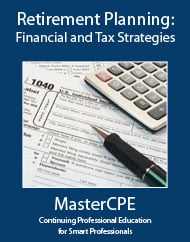Course Information
Retirement Planning – Financial and Tax Strategies
Course Information
| Title: | Retirement Planning – Financial and Tax Strategies |
|---|---|
| Category: | Taxation |
| Field of Study: | Taxes |
| Course Code: | M289 |
| CPE Credits: | 17.0 |
| Price: | 89.95 |
Description
Description:
This presentation integrates federal taxation with retirement planning. The course will examine tax and savings strategies related to determining retirement income needs, wealth building, capital preservation, and estate distribution. The result is a unified explanation of tax-economics that will permit the tax professional to locate, analyze, and solve financial aspects of retirement. Designed to improve the quality of services to clients and the profitability of engagements, this program projects the accountant into the world of retirement planning. This course will give the participant practice in analyzing problems, developing solutions, and presenting final personal retirement plans to clients. The emphasis is on practical simplicity in dealing with the self-employed and highly compensated individual.
Delivery Method: Online Interactive Self Study
Level: Overview
Prerequisites: None
Advanced Preparation: None
Course Details
Category: Taxation
Field of Study: Taxes
Passing Score: 70%
Technical Details: Taxation is a technical field of study for all states.
For More Detail:
If you are unable to view PDF then right click the mouse and click save link as
Objectives
Objectives:
Chapter 1: Financial Tax Planning 1. Identify short-term financial goals and investment purposes, recognize the importance of defining, listing and prioritizing realistic goals and how investing allocation changes with age. 2. Determine the tax consequences of title holding methods by: a. Specifying ways to hold title to assets starting with the simplest and most direct way to hold property; b. Cite the tax benefits and drawbacks of co-tenancies, corporations (both C & S), partnerships, qualified retirement plans, and trusts particularly as they relate to a client’s after-tax investment return; and c. Identifying custodianship under the uniform acts and determining how an estate can be tax beneficial to taxpayers. 3. Recognize the impact of retirement planning postponement and the importance of early planning using the author’s suggested step process, specify a balance sheet method to plan retirement, determine how to diversify portfolios by balancing liquid and nonliquid assets, and identify the purpose of s
For More Objectives:
If you are unable to view PDF then right click the mouse and click save link as
Profession
NASBA: Yes
QAS: Yes
CPA: Suitable for all CPAs
IRS: IRS credit for Enrolled Agents.
Profession Identifiers: CPA, EA

